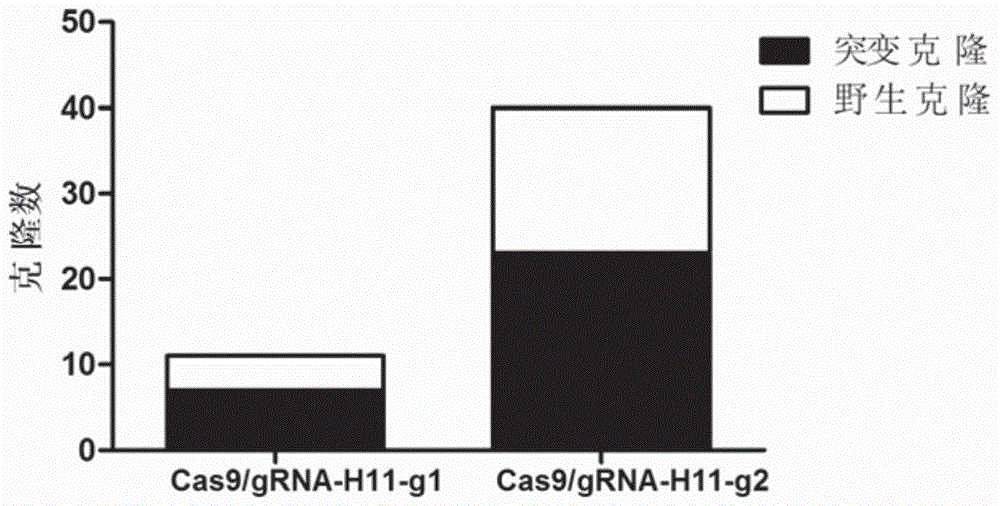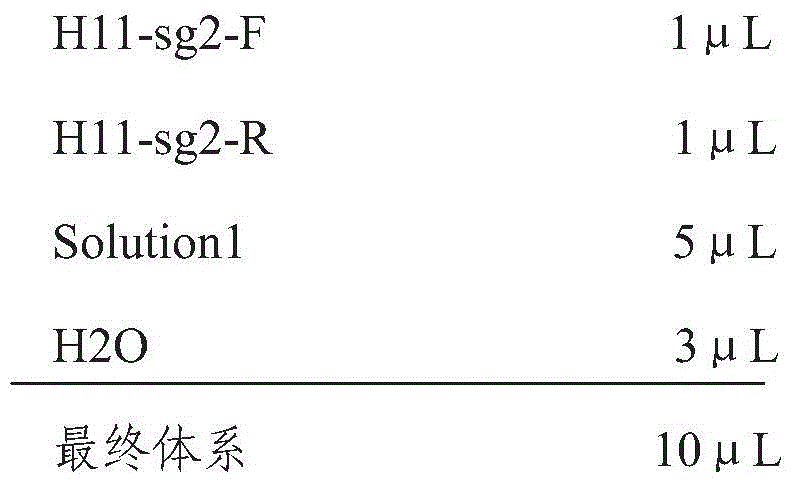The sgRNA that specifically recognizes porcine h11 locus and its coding dna and application
A technology for specific recognition and DNA molecules, applied in the field of sgRNA and its coding DNA, to achieve the effect of reducing off-target phenomenon and strong specificity
- Summary
- Abstract
- Description
- Claims
- Application Information
AI Technical Summary
Problems solved by technology
Method used
Image
Examples
Embodiment 1
[0022] Example 1 Construction of sgRNA expression plasmid
[0023] 1. The H11 site sequence of the pig is called out in the gene bank, and its nucleotide sequence is shown in sequence 5 in the sequence table. The sgRNA target for gene knockout is selected according to the PAM sequence, and the PAM sequence is NGG:
[0024] sgRNA target site position 1 (named H11-sg1): GTTCCTGGAAGTTTAGATCAGGG, the nucleotide sequence that recognizes the target in the corresponding sgRNA sequence is shown in sequence 1 in the sequence listing; the DNA sequence encoding the above sequence is shown in the sequence listing Sequence 3 in.
[0025] sgRNA target site position 2 (named H11-sg2): AGATCAGGGTGGGCAGCTCTGGG, the corresponding sgRNA sequence recognizes the target nucleotide sequence as shown in sequence 2 in the sequence listing; the DNA sequence encoding the above sequence is shown in the sequence listing as shown in sequence 4.
[0026] 2. Construction of sgRNA expression plasmid
[002...
Embodiment 2
[0047] Example 2 Efficiency verification of sgRNA expression plasmid
[0048] 1. Isolation of porcine fetal fibroblasts
[0049] PEF cells were isolated from aborted pig fetuses. For specific isolation methods, please refer to the literature: Li Hong, Wei Hongjiang, Xu Chengsheng, Wang Xia, Qing Yubo, Zeng Yangzhi; biological characteristics.
[0050] 2. Nucleofection
[0051] 4 μg each of the recombinant plasmids Cas9 / gRNA-H11-sg1 and Cas9 / gRNA-H11-sg2 obtained in Example 1 were transfected into PEF cells by electroporation to obtain recombinant cells. The specific steps of transfection are as follows: use a nuclear transfer instrument (Amaxa, model: AAD-1001S) and a matching mammalian fibroblast transfection kit (Amaxa, product number: VPI-1002) for transfection. First, use 0.1% trypsin (Gibco, catalog number: 610-5300AG) to digest adherent cells, stop digestion with fetal bovine serum (Gibco, catalog number: 16000-044), and wash with phosphate buffer saline (Gibco, catalog...
PUM
 Login to View More
Login to View More Abstract
Description
Claims
Application Information
 Login to View More
Login to View More - R&D
- Intellectual Property
- Life Sciences
- Materials
- Tech Scout
- Unparalleled Data Quality
- Higher Quality Content
- 60% Fewer Hallucinations
Browse by: Latest US Patents, China's latest patents, Technical Efficacy Thesaurus, Application Domain, Technology Topic, Popular Technical Reports.
© 2025 PatSnap. All rights reserved.Legal|Privacy policy|Modern Slavery Act Transparency Statement|Sitemap|About US| Contact US: help@patsnap.com



